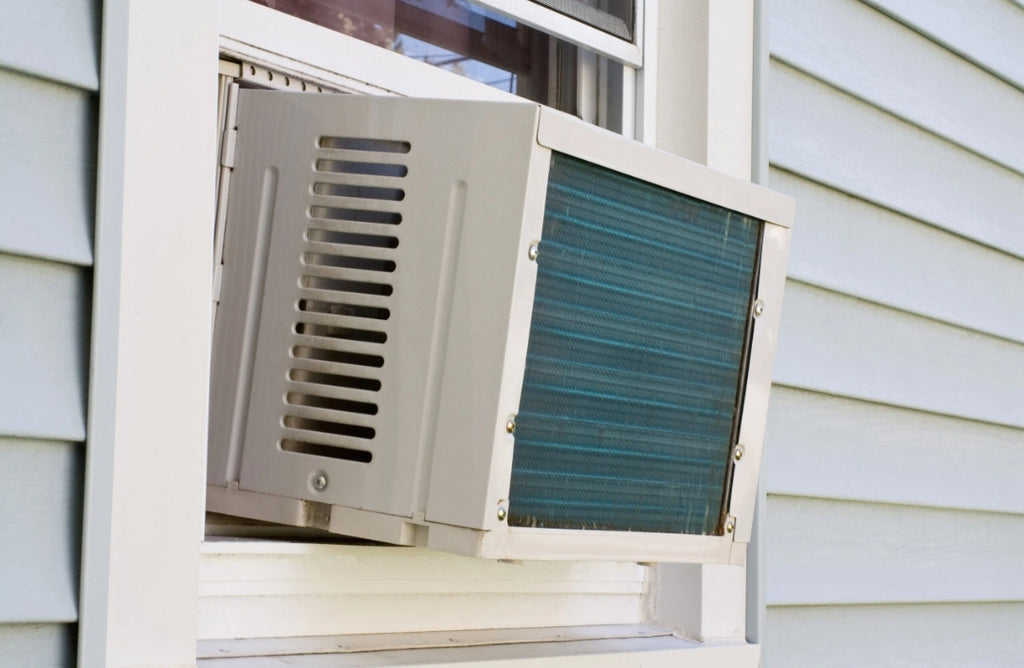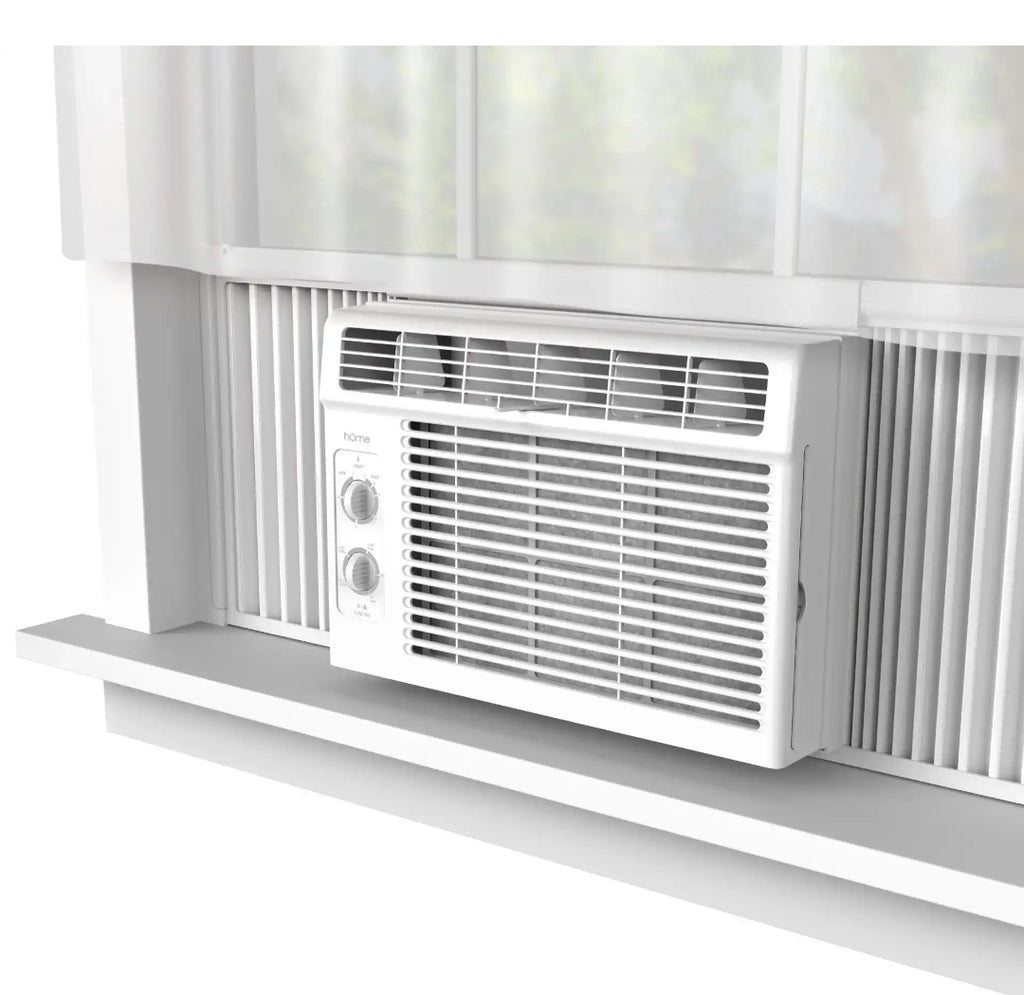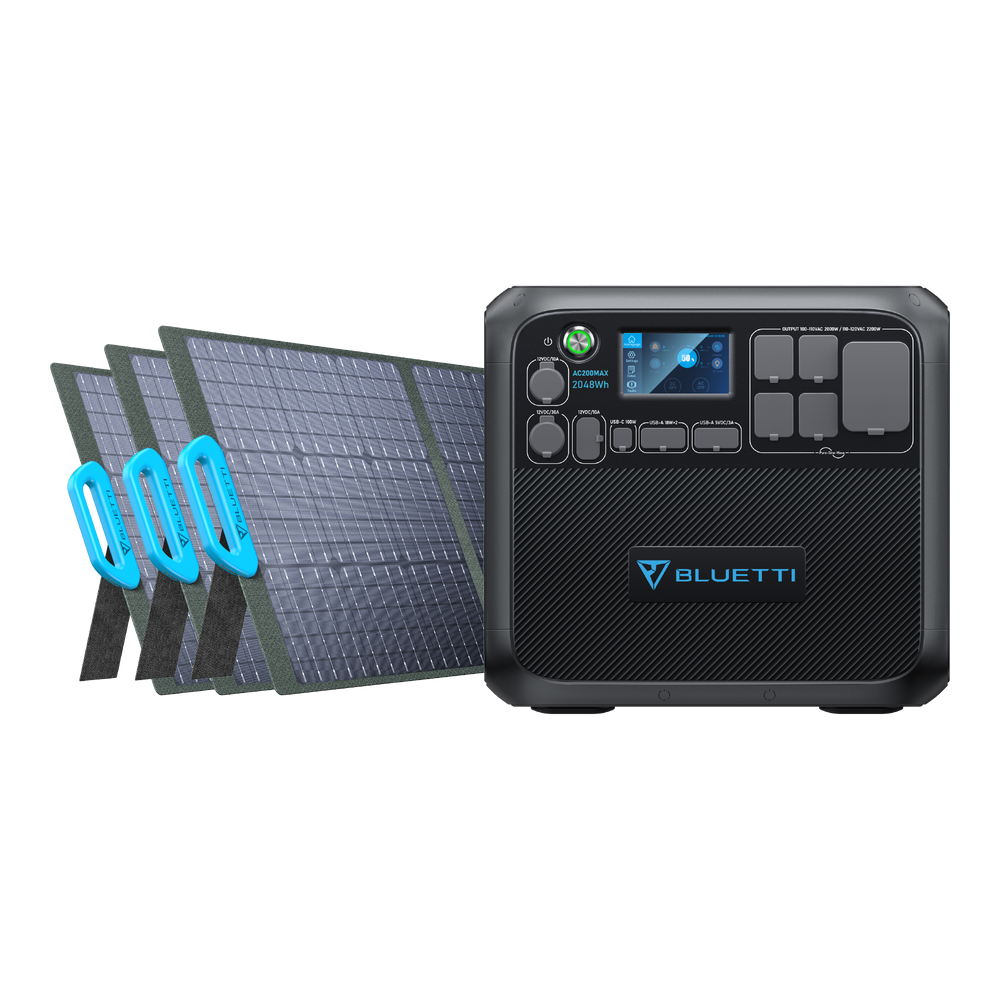Your cart is empty
Shop our productsWindow AC has become an essential appliance for cooling indoor spaces. They provide relief from the scorching heat during the hot summer months. However, energy consumption and environmental concerns continue to gain significance. For this reason, it becomes crucial to understand the power requirements of window air conditioners, and how to use solar generators to power your devices will be important.
One fundamental aspect of measuring energy consumption is determining the watts consumed by a window AC. Knowing the power usage can allow individuals to:
-
Make informed decisions about their energy consumption
-
Optimize efficiency
-
Evaluate the impact on their electricity bills
This article will delve into the energy consumption in Window AC units. Sections in this guide will also discuss the best solar generators for a Window AC. To know more, don't stop reading!
Understanding Energy Consumption in Window AC Units
Wattage is a measurement unit that quantifies the rate of energy transfer or consumption by an electrical appliance. It represents the amount of electrical power the appliance uses. It can also estimate the amount of power it can handle. In other words, wattage indicates the amount of electricity an appliance needs to operate. It can also describe the amount of electricity it generates or outputs.

Before you purchase appliances, it's important to consider their wattage with respect to your electrical system's capacity. Make sure your electrical infrastructure can handle the power requirements of the appliances you intend to use. This may include the following:
-
Outlets
-
Wiring
-
Circuit breakers
It must be noted that wattage alone does not indicate the overall energy efficiency of an appliance. Energy efficiency depends on various factors, including:
-
The design
-
Technology
-
Usage patterns of the appliance
Ensure that you pay attention to appliances with energy efficiency ratings, including ENERGY STAR certifications. This feature helps to identify models that consume less power for the same level of performance.
Several factors can affect the wattage or power consumption of a window air conditioning (AC) unit. Here are the main factors:
-
Cooling capacity: The cooling capacity of an AC unit is measured in British Thermal Units and directly impacts its wattage. AC units with higher cooling capacities typically require more power to operate. A higher BTU rating indicates a larger cooling capacity. This translates to higher energy consumption.
-
Energy efficiency: The energy efficiency of the AC unit plays a significant role in its wattage. AC units with higher energy efficiency ratings will consume less power for the same cooling output. Look for AC units with ENERGY STAR certifications or high Seasonal Energy Efficiency Ratio (SEER) ratings. After all, they indicate better energy efficiency.
-
Ambient temperature: The temperature of the surrounding environment also impacts the AC unit's wattage. If the outside temperature is higher, the AC unit will need to work harder to cool the room. This results in increased power consumption.
-
Insulation and room size: The level of insulation in the room and the overall size of the space can influence the AC unit's power consumption. A well-insulated room with proper sealing will retain cool air better, allowing the AC unit to operate more efficiently. Additionally, larger rooms or spaces may require AC units with higher cooling capacities. Such cooling capacities generally consume more power.
How Many Watts Does A Window AC Use?
Understanding energy efficiency ratings is important when considering the energy consumption and cost of an appliance. Some key terms and rating systems related to energy efficiency are mentioned as follows:
-
ENERGY STAR: ENERGY STAR is an international standard for energy-efficient consumer products. Appliances that meet certain criteria set by the Environmental Protection Agency (EPA) and the Department of Energy (DOE) can receive the ENERGY STAR certification. These appliances are designed to use less energy and help reduce greenhouse gas emissions.
-
Energy Efficiency Ratio (EER): The Energy Efficiency Ratio is a measure of an air conditioner's cooling capacity divided by its power consumption. It represents the appliance's efficiency in converting electrical energy into cooling output. A higher EER indicates greater energy efficiency. This implies that the AC unit produces more cooling per unit of electricity consumed.
-
Seasonal Energy Efficiency Ratio (SEER): SEER is a measure of an air conditioner's cooling output over a typical cooling season. This result is divided by its total power consumption during that period. SEER takes into account variations in cooling needs at different times of the year. A higher SEER rating signifies better energy efficiency. SEER is typically used for central air conditioning systems.
-
Conditioning Energy Efficiency Ratio (CEER): CEER is specifically used for room air conditioners. This metric is calculated by dividing the cooling capacity by the power input required to operate the unit. The higher the CEER rating, the more energy-efficient the air conditioner is. CEER is similar to the Energy Efficiency Ratio (EER). However, CEER takes into account the energy consumption during both the cooling and standby modes. These details provide a more comprehensive evaluation of the unit's overall efficiency.

Breakdown of the average wattage for common window AC unit sizes
The wattage or power consumption of window air conditioning (AC) units can vary based on their cooling capacity or BTU rating:
-
5,000 BTU: A 5,000 BTU window AC unit, typically used for small rooms or spaces, generally consumes around 450 to 550 watts of power.
-
6,000-8,000 BTU: Window AC units with a cooling capacity of 6,000 to 8,000 BTUs, suitable for medium-sized rooms, typically consume around 600 to 800 watts of power.
-
10,000-12,000 BTU: AC units in the range of 10,000 to 12,000 BTUs, suitable for larger rooms or open floor plans, generally consume around 900 to 1,200 watts of power.
-
14,000-18,000 BTU: Window AC units with a cooling capacity of 14,000 to 18,000 BTUs, often used for larger areas or multiple rooms, can consume around 1,300 to 1,800 watts of power.
It is worth noting that these wattage ranges are average estimates and can vary depending on certain factors:
-
The specific model
-
Brand
-
Energy efficiency of the AC unit.
A table below shows the average wattage and CEER for common room air conditioner unit sizes without reverse cycle and with louvered sides:
|
AC Unit Size (BTUs) |
Average Wattage (W) |
CEER Range |
|
5,000 - 6,000 |
450 - 550 |
12 - 13 |
|
6,000 - 8,000 |
600 - 800 |
13.7 |
|
10,000 - 12,000 |
900 - 1,200 |
16.0 |
|
14,000 - 18,000 |
1,300 - 1,800 |
16.0 |
|
18,000 - 24,000 |
1,900 - 2,500 |
13.8 |
Another table below shows the average wattage and CEER for common room air conditioner unit sizes without reverse cycle and with louvered sides:
|
AC Unit Size (BTUs) |
Average Wattage (W) |
CEER Range |
|
5,000 - 6,000 |
450 - 550 |
11 - 12 |
|
6,000 - 8,000 |
600 - 800 |
12.8 |
|
8,000 - 11,000 |
800 - 1,200 |
14.1 |
|
11,000 - 14,000 |
1,200 - 1,500 |
13.9 |
|
14,000 - 18,000 |
1,500 - 1,800 |
13.7 |
Please note that these wattage ranges are approximate and can vary based on certain factors. These may include the specific model and energy efficiency rating.
Comparison of energy usage between different models and brands
Comparing energy usage between different models and brands of appliances can be done by looking at their energy efficiency ratings and specific power consumption data. Here's how you can compare energy usage:
-
Energy Efficiency Ratings: Pay attention to energy efficiency ratings specific to the appliance type. For example, air conditioners have ratings like EER or SEER. On the other hand, refrigerators have ratings like EnergyGuide labels or Energy Efficiency Index. Higher ratings indicate better energy efficiency.
-
Power Consumption Data: Manufacturers often provide power consumption data in product specifications or user manuals. This data may be presented in watts or kilowatt-hours (kWh). Compare the power consumption figures of different models and brands. This helps to identify those that consume less energy for the same level of performance.
-
Customer Reviews and Expert Opinions: Consider reading customer reviews and expert opinions. This knowledge offers insights into the energy efficiency and real-world performance of different models and brands. Other users' experiences can provide valuable information regarding energy usage and efficiency.
What Watts Generator Do I Need For Window AC
One of the most important considerations when installing a window air conditioner is how much power it will draw from your generator.
The running wattage for a 5000 BTU air conditioner is approximately 450. An 8000 BTU air conditioner may use as little as 715 watts. This usage depends on the size of the space. 1250 watts is all that is needed for a 14000 BTU air conditioner.
A 1000-watt generator can run a small to medium-sized window unit without any issues. A large window unit will require at least a 2000-watt generator. A larger generator can be a better option to power many appliances simultaneously.
Best Solar Generator for a Window AC
As mentioned above, the importance of getting the right generator for your Window AC cannot be stressed enough. Luckily, this section will delve into some of the best solar generators to look out for. So, keep on reading!
1. BLUETTI AC300+B300
This is a highly flexible power station that can be easily carried around. Users can simply disassemble the combo and move the spare parts one after the other. This power station provides a perfect way to reduce the electric bill with minimum maintenance.
BLUETTI AC300 and B300 combo features a robust 3,000W AC pure sine wave inverter (6,000W Surge) and an impressive 3,072Wh capacity. Plus, it's expandable with up to 4 × B300 batteries, offering a staggering 12,288Wh capacity for all your energy needs.

2. BLUETTI AC200MAX + 3*PV200 | Solar Generator Kit
For reliability and efficiency, BLUETTI AC200MAX + 3*PV200 is a top choice to consider. This solar generator kit is packed with some amazing features as follows:
-
2,200W AC Pure Sine Wave Inverter (4,800W Surge)
-
2,048Wh Capacity
-
LiFePO4 Battery with 3,500+ Life Cycles to 80%
-
Expandable Up To 6,144Wh with 2×B230, or 8,192Wh with 2×B300
-
7 Ways to Recharge (AC/Solar/Car/Generator/Lead Battery/Dual AC/AC+Solar)
-
900W Max. Solar Input
-
1,400W Max. Fast Dual Charging (Solar + AC Adapter)
-
Smart Control & Monitor in BLUETTI App

3. BLUETTI EP500 Solar Power Station | 2,000W 5,100Wh
This solar power station comes with a massive 5,100Wh capacity and 2,000W rated wattage. BLUETTI EP500 Solar Power Station is designed with the following features:
-
5,100Wh LiFePO4, 3,500+ Cycles to 80% Capacity
-
2,000W Pure Sine Wave Inverter
-
Movable Power Station
-
In-grid UPS Mode & Flexible UPS Mode (24/7)
-
Off-grid Energy Storage
-
Multiple Devices Can Be Loaded Simultaneously
-
Flexible Recharging Way
-
App Remote Control
-
Smart Touchscreen
BLUETTI EP500 Solar Power Station
Related articles: BLUETTI EP500: Future Of Home Backup Power
Best Solar Generator for Your Home/RV Air Conditioner
Final Thoughts
As mentioned in this guide, it is important to understand the energy consumption in Window AC units. Users should also understand the various factors that can influence the wattage of a window AC unit. Furthermore, installing a window AC unit requires choosing the right generator. The best solar generators are provided by BLUETTI, as introduced above.
FAQs
1. Can energy-efficient window ACs use fewer watts?
Ans: Yes, energy-efficient window ACs can use fewer watts than standard models, resulting in lower energy consumption.
2. Can the wattage of a window AC vary based on its cooling capacity?
Ans: Yes, the wattage of a window AC can vary depending on its cooling capacity. Higher cooling capacities may result in higher wattage usage.
3. Is the wattage usage of a window AC constant or variable?
Ans: The wattage usage of a window AC can vary depending on factors such as:
-
The desired temperature
-
Cooling settings
-
The ambient temperature
4. How does the wattage of a window AC affect electricity bills?
Ans: The higher the wattage of a window AC, the more electricity it consumes. This higher consumption results in higher electricity bills.
5. What is the power consumption of a small window AC?
Ans: Small window AC units generally consume between 500 to 800 watts.
Shop products from this article
Be the First to Know
You May Also Like

What Does a 30% Federal Solar Tax Credit Mean and How to Apply?
Governments around the world are offering programs that encourage homeowners to switch to solar energy. Among the most notable programs is the 30% Federal Solar Tax Credit. It reduces your...

Deadly Flooding Devastates U.S. South and Midwest — What You Need to Know

















































































































































































































































